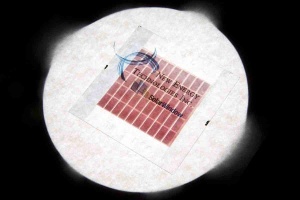Sep 21 2010
New Energy Technologies, Inc. (OTCBB: NENE) successfully debuted its proprietary SolarWindow™ technology, capable of transforming everyday surfaces, such as glass, into electricity-generating windows, on September 16 at the University of South Florida (USF) to a standing-room-only crowd of investors, academics, commercial glass companies, and members of the media, including: CNBC, CNN, The Tampa Tribune, The St. Petersburg Times, The Oracle, NBC affiliate WFLA-TV Ch. 8, Bay News 9, WUSF Public Media, and global news service, Agence France Presse.
Company President and CEO, Mr. John A. Conklin, revealed that the application of SolarWindow™ to exterior glass surfaces of commercial towers could generate energy savings several-fold greater than today’s rooftop solar systems during his introduction of New Energy’s SolarWindow™, the world’s first see-thru, spray-on technology of its kind.
In commercial applications, such as the building facades of office towers, engineers conservatively estimate that installation of New Energy’s SolarWindow™ can generate more than 300% energy savings over conventional rooftop solar systems. Key to maximizing energy production, SolarWindow™ can be applied to the extensive glass surfaces on commercial skyscrapers, an important advantage over conventional solar systems confined to installation on space-prohibitive rooftops.
 See-thru SolarWindow(TM) prototype unveiled at debut event on September 16th, shown to generate electricity with both artificial and natural light.
See-thru SolarWindow(TM) prototype unveiled at debut event on September 16th, shown to generate electricity with both artificial and natural light.
By way of example, engineers modeling a 40-story building, similar to Tampa’s landmark “100 North Tampa,” estimate annual cost-savings of $40,000 to $70,000 when installing New Energy’s SolarWindow™ to exposed window facades. In contrast, mounting today’s popular poly-crystalline silicon modules on the rooftop produces only $20,000 in energy savings per year.
The Company expects to publish comprehensive performance data in upcoming weeks, following independent, third-party measurement and engineering validation.
“The successful public demonstration of SolarWindow™ boldly underscores our confidence in the technology, and marks a significant achievement for all of our stakeholders who have patiently supported us as we’ve worked towards this milestone,” stated Mr. Conklin. “I’m eager to aggressively advance this technology towards commercial prototyping in preparation for eventual full-scale production to capitalize on our market of more than five million commercial buildings and 80 million detached homes in America.”
SolarWindow™: Early Performance Prompts Commercialization Efforts
Researchers at the debut event shared early technical hurdles and subsequent achievements which enabled advancement from concept to working prototype, further explaining that efforts are now focused on product development for commercialization of New Energy’s see-thru SolarWindow™.
SolarWindow™ is made possible by spraying an electricity-generating coating on to glass at room temperature– an important attribute highlighted by researchers. Scientists also demonstrated numerous features of New Energy’s SolarWindow™, including its ability to remain see-thru while generating electricity. Unique to SolarWindow™, both natural and artificial light were used in demonstrations to generate electricity.
Following Mr. Conklin’s introduction, scientists powered lights on a scale-model house by exposing New Energy’s see-thru SolarWindow™ to artificial light from fluorescent lamps, mimicking lighting typically installed inside offices. In artificial light, SolarWindow™ technology outperforms today’s commercial solar and thin-films by as much as 10-fold under low-intensity irradiance.
Researchers then repeatedly opened and closed the boardroom’s window shades, successfully powering LED lights each time SolarWindow™ was exposed to natural light. This demonstration mimicked outdoor exposure such as sunlight on the exterior façade of commercial buildings – New Energy’s initial target market and a promising early application of its technology.
Importantly, scientists at the event not only demonstrated the ability to generate ‘voltage’ to power lighting, but also revealed SolarWindow’s capacity to produce ‘current’ necessary for powering mechanical devices and appliances.
Following a boardroom display of LED lights powered by SolarWindow™ using both natural sunlight and artificial fluorescent light sources, attendees crowded inside inventor and Lead Researcher Dr. Xiaomei Jiang’s laboratory where PhD-candidate and Researcher Jason Lewis, successfully powered the mechanical rotor blades of a small helicopter using only a single, small-scale SolarWindow™ prototype.
New Energy’s working SolarWindow™ prototype is a precursor to the development of a commercial scale prototype and eventual full-scale production. Low production costs, improved manufacturability and increased power performance are among important, recently announced objectives researchers are now targeting. Key to these advances are the development of new methods and technologies for applying New Energy’s electricity-generating coatings to glass surfaces.
Electrical power is generated on glass when New Energy’s SolarWindow™ coatings are sprayed onto surfaces using commercially available equipment. This patent-pending process enables researchers to spray SolarWindow™ coatings onto glass at room temperature, eliminating expensive and often cumbersome high-temperature or high-vacuum production methods typically used by current solar manufacturers.
Source: http://www.newenergytechnologiesinc.com/